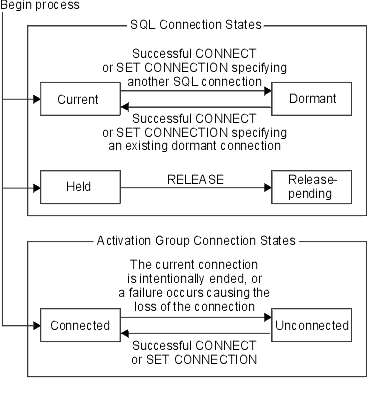Application-directed distributed unit of work
The application-directed distributed unit of work facility also provides for the remote preparation and execution of SQL statements in the same fashion as remote unit of work. Like remote unit of work, an activation group at computer system A can connect to an application server at computer system B and execute any number of static or dynamic SQL statements that reference objects at B before ending the unit of work. All objects referenced in a single SQL statement must be managed by the same application server. However, unlike remote unit of work, any number of application servers can participate in the same unit of work. A commit or rollback operation ends the unit of work.
Distributed unit of work is fully supported for APPC and TCP/IP connections.
Application-directed distributed unit of work connection management
At any time:
- An activation group is always in the connected or unconnected state and has a set of zero or more connections. Each connection of an activation group is uniquely identified by the name of the application server of the connection.
- An SQL connection is always in one of the following states:
- Current and held
- Current and release-pending
- Dormant and held
- Dormant and release-pending
Initial state of an activation group:
An activation group is initially in the connected state and has exactly one connection. The initial state of a connection is current and held.
The following diagram shows the state transitions:

Connection states
If an application process successfully executes a CONNECT statement:
- The current connection is placed in the dormant state and held state.
- The server name is added to the set of connections and the new connection is placed in the current and held state.
If the server name is already in the set of existing connections of the activation group, an error is returned.
A connection in the dormant state is placed in the current state using the SET CONNECTION statement. When a connection is placed in the current state, the previous current connection, if any, is placed in the dormant state. No more than one connection in the set of existing connections of an activation group can be current at any time. Changing the state of a connection from current to dormant or from dormant to current has no effect on its held or release-pending state.
A connection is placed in the release-pending state by the RELEASE statement. When an activation group executes a commit operation, every release-pending connection of the activation group is ended. Changing the state of a connection from held to release-pending has no effect on its current or dormant state. Thus, a connection in the release-pending state can still be used until the next commit operation. There is no way to change the state of a connection from release-pending to held.
Activation group connection states
A different application server can be established by the explicit or implicit execution of a CONNECT statement. The following rules apply:
- An activation group cannot have more than one connection to the same application server at the same time.
- When an activation group executes a SET CONNECTION statement, the specified location name must be an existing connection in the set of connections of the activation group.
- When an activation group executes a CONNECT statement, the specified server name must not be an existing connection in the set of connections of the activation group.
If an activation group has a current connection, the activation group is in the connected state. The CURRENT SERVER special register contains the name of the application server of the current connection. The activation group can execute SQL statements that refer to objects managed by that application server.
An activation group in the unconnected state enters the connected state when it successfully executes a CONNECT or SET CONNECTION statement.
If an activation group does not have a current connection, the activation group is in the unconnected state. The CURRENT SERVER special register contents are equal to blanks. The only SQL statements that can be executed are CONNECT, DISCONNECT, SET CONNECTION, RELEASE, COMMIT, and ROLLBACK.
An activation group in the connected state enters the unconnected state when its current connection is intentionally ended or the execution of an SQL statement is unsuccessful because of a failure that causes a rollback operation at the current server and loss of the connection. Connections are intentionally ended when an activation group successfully executes a commit operation and the connection is in the release-pending state, or when an application process successfully executes the DISCONNECT statement.
When a connection is ended
When a connection is ended, all resources that were acquired by the activation group through the connection and all resources that were used to create and maintain the connection are deallocated. For example, if application process P has placed the connection to application server X in the application server state, all cursors of P at X will be closed and deallocated when the connection is ended during the next commit operation.
A connection can also be ended as a result of a communications failure in which case the activation group is placed in the unconnected state. All connections of an activation group are ended when the activation group ends.